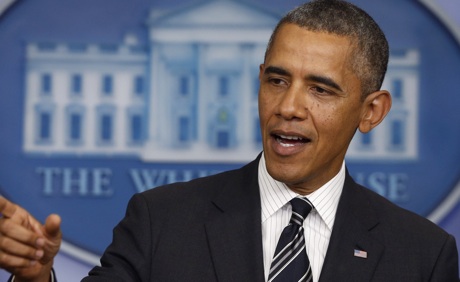President Obama
[The White House]
Today at an event with the First Lady at Coral Reef High School in Miami, President Obama will lay out additional details of his plan to equip all Americans with the education and skills they need to compete in the 21st century economy and launch a new FAFSA Completion Initiative to give more Americans the opportunity to afford, attend, and graduate from college.
The President’s budget, released earlier this week, includes investments and initiatives to expand opportunity for all Americans by improving education at every level, from early childhood through college. But the President has also been clear that while he wants to work with Congress wherever they are willing, he is also going to make 2014 a year of action and won’t hesitate to take steps on his own wherever he can.
That’s why today President Obama will announce the launch of a new FAFSA Completion Initiative, led by the Department of Education, to help ensure that more of America’s students take the first step towards college success: completing the Free Application for Federal Student Aid (FAFSA) form. Today’s announcement includes new tools and resources to enable states, districts, and high schools to better support students to complete this critical form in a timely fashion:
The Department of Education will partner with states so they can identify individual students who have not completed the FAFSA. States can then use this limited, yet valuable, information to support school and district efforts to increase FAFSA completion beginning in the 2014-15 school year. These efforts build on the success of a pilot project launched by the U.S. Department of Education in 2010 working directly with about 100 school districts.
The Office of Federal Student Aid has also updated the existing FAFSA completion tool with new, overall FAFSA completion numbers for the high school graduating class of 2014, and is expanding that tool to include more than 25,000 high schools nationwide. The completion tool is targeted at school and district leaders, but also allows anyone with web access to track the overall number of FAFSA forms completed by students at particular schools, in order to effectively provide outreach and resources as well as support community efforts to increase FAFSA completion.
Building on Success: Filing the FAFSA is required in order for students to receive access to Title IV student aid programs, like the Federal Pell Grant and Federal student loans. It also is used by states, colleges, and universities in awarding other state-based or institution-based aid. Nonetheless, millions do not file a FAFSA each year, and many who do not may be eligible for federal student aid.
In order to ensure that the FAFSA is not a barrier to college access for students, President Obama took steps early in his Administration to simplify the FAFSA, including revamping the online form to skip questions that are irrelevant to individual students and to allow students and parents to answer many questions with pre-existing data from the Internal Revenue Service. These efforts have contributed to 33% increase in the number of FAFSA forms filed over the course of the Administration, growing from 16.4 million in 2008-2009 to 21.8 million in 2012-13.
Increasing FAFSA completion is just one of the critical efforts the Administration is taking to help prepare America’s students for college and for successful careers. In Miami, the Miami-Dade County Public Schools district has leveraged federal support through critical initiatives like Race to the Top, the Teacher Incentive Fund, and the School Improvement Grant program to implement reforms that have helped Miami make significant strides to close achievement gaps and address inequities, promote digital learning, and strengthen pathways to college and careers.
Making Investments in America’s Future: The President has set a goal for the country that, by the end of this decade, America will once again lead the world in college graduation. The President’s budget includes critical investments to strengthen educational opportunity from early childhood and preschool, all the way through college and career placement. Beyond the investments in the base budget described below, the fully paid-for Opportunity, Growth, and Security Initiative included in the President’s budget would provide additional funding for Race to the Top, High School Redesign, and ConnectEDucators.
Race to the Top: The President’s budget provides $300 million for a new Race to the Top: Equity and Opportunity competition, incentivizing states and school districts to undertake comprehensive efforts to close achievement and opportunity gaps by attracting and retaining effective teachers and leaders, enhancing student supports, increasing access to rigorous coursework, and leveraging data to improve outcomes for students. RTT–Opportunity would reinforce the existing Race to the Top program that has spurred reform and systemic change in states and districts across the country, including in Miami-Dade. Miami-Dade is a recipient of a $32 million Race to the Top-District grant to personalize learning and change instruction in the district’s middle schools.
High School Redesign: President Obama has called on Congress to invest $150 million in a new vision of high school learning where coursework is tied to real-world experiences. Students in redesigned high schools pursue rigorous academic curricula through project-based learning, career-related experiences, and innovative uses of learning time. At Coral Reef High School, each student chooses one of five academies based around the themes of Health Sciences, Agricultural Science & Engineering, Legal & Public Affairs, Visual and Performing Arts, and the International Baccalaureate program.
ConnectEDucators: The future of learning is going to be driven by new digital technologies, and will be increasingly interactive and individualized. To deliver that opportunity to every American child, the President’s FY 15 budget proposes $200 million to help prepare and support teachers as they work to integrate digital learning into their classrooms and lessons. President Obama has set a goal to connect 99 percent of America’s students to high-speed broadband in their schools, within five years, and has already inspired over $1 billion in private-sector commitments to schools. In Miami-Dade, the school has installed high-speed broadband in every one of its schools, consistent with this initiative.
College Opportunity and Graduation Bonus: To reward colleges that successfully enroll and graduate a significant number of low- and moderate-income students on time and encourage all institutions to improve their performance, the President’s FY 15 budget includes a new College Opportunity and Graduation Bonus program to provide an annual grant to eligible institutions based on their number of on-time graduates that receive Pell Grants, at a total 10-year cost of $7 billion.
State Higher Education Performance Fund: To encourage systemic efforts to make higher education more affordable and increase college access and success, particularly for low-income students, the President’s FY 15 budget includes a $4 billion State Higher Education Performance Fund for States to support, reform, and improve the performance of their public higher education systems. States would receive up to four years of funding, and would match their federal grants, dollar-for-dollar, for a total of $8 billion in four years.
First in the World: The President has called on Congress to advance new innovations to help ensure that college is affordable for all students. The FY 15 budget includes $100 million for a First in the World fund that would support innovative strategies and practices that improve college affordability and produce high-quality outcomes for students.







